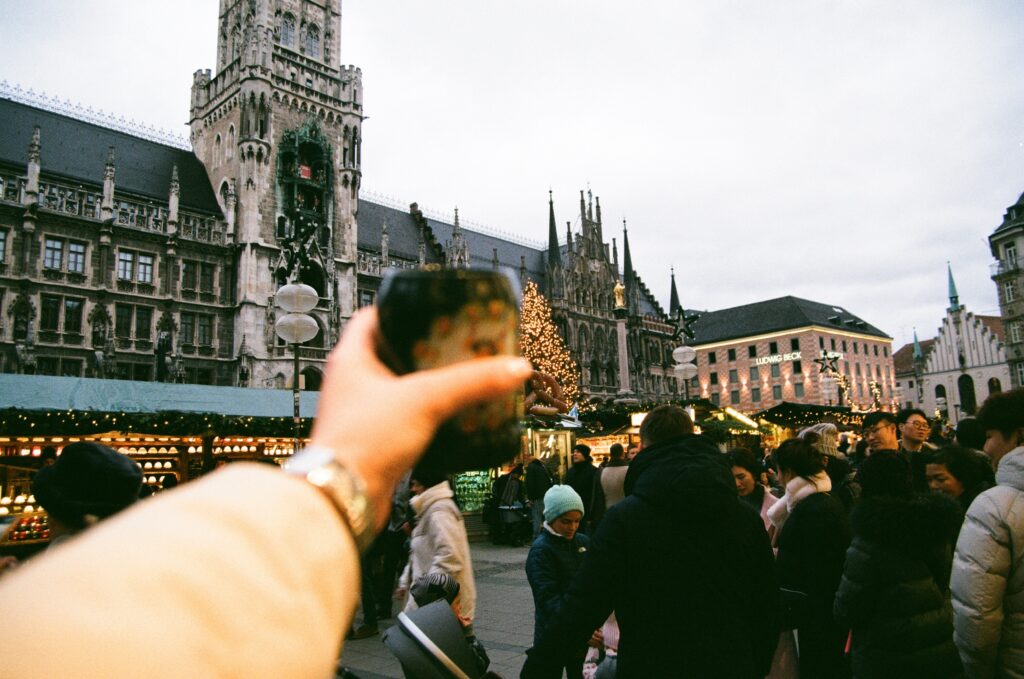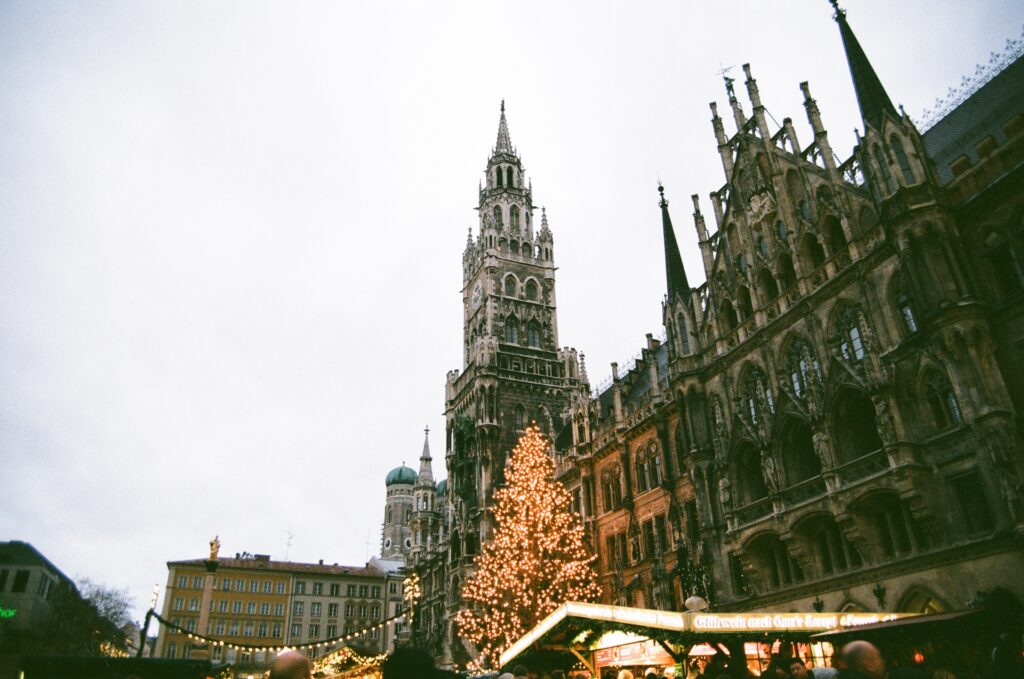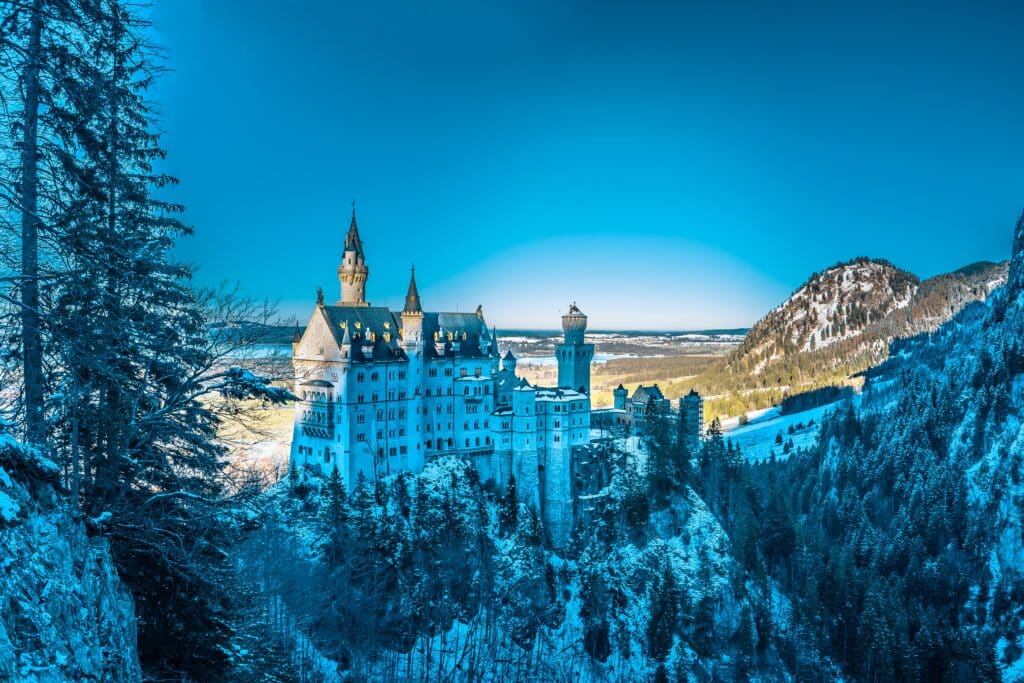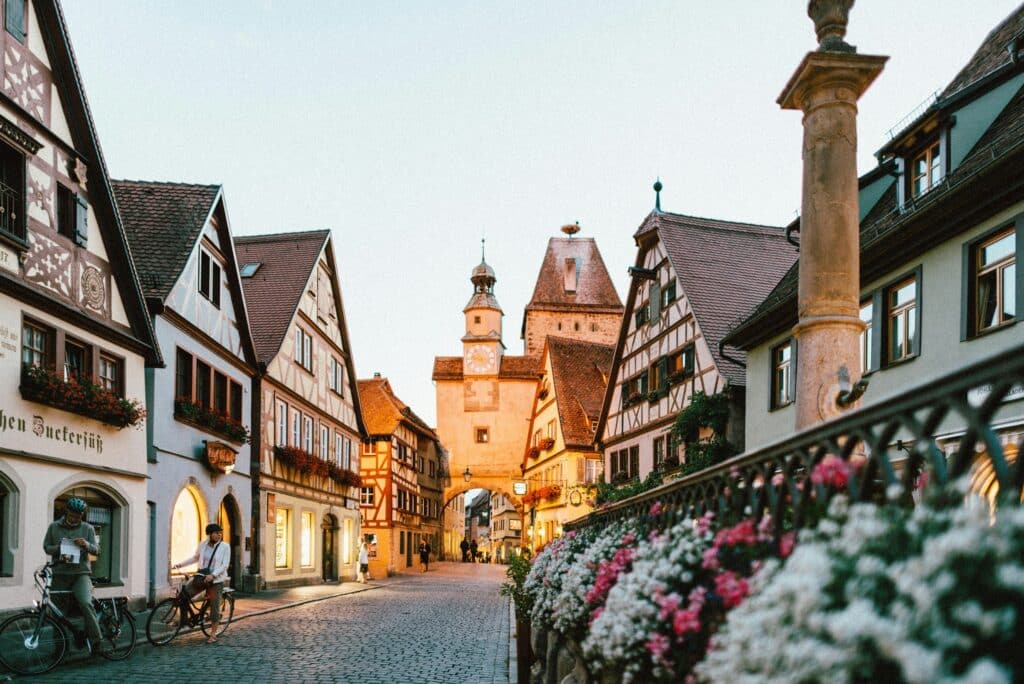
On behalf of everyone here at Remitly, Merry Christmas to our customers in Germany and around the world.
Despite 40% of Germans having no religious affiliation, Christmas in Germany is a widely celebrated holiday. More than three-quarters of all Germans observe it, and cities and villages across the country are transformed into winter wonderlands every December in honor of the season.
Let’s explore German Christmas traditions from past to present, from Krampus to Christmas angels.
Table of Contents
What is Christmas in Germany called?
In Germany, Christmas time is called Weihnachten.
The word combines the German verb weihen, which means “to consecrate,” and nacht, which means “night.”
During the season, the standard greeting is “Frohe Weihnachten!” To pronounce it, say: “FRO-eh VINE-ahk-tin.”
What is Krampusnacht?
Germans believe that St. Nicholas has a devilish sidekick named Krampus.
While the good children receive gifts, the monstrous figure punishes the naughty ones. On December 5, he visits to scare children who have misbehaved.
In Bavaria, people often dress in scary costumes, don horns, and knock on doors, asking if any naughty children are inside. Parents may invite them in as a part of the spooky fun.
What is Sankt Nikolaus Tag?
Also known as Nikolaustag, Sankt Nikolaus Tag is St. Nicholas Day, a celebration of St. Nikolaus, the Bishop of Myra.
Saint Nicholas Day takes place the day after Krampusnacht on December 6. In the evening, children place stockings or sock-shaped bags outside of their doors in hopes of a visit from the beloved figure.
When they wake up on December 7, they find oranges, chocolates, small toys, and other goodies waiting for them to open. Although St. Nikolaus is a religious figure, this tradition is secular and observed by anyone who wants to.
What is Heiliger Abend?
Heiliger Abend or Heiligabend is Christmas Eve in Germany.
Businesses usually open in the morning but typically close in the afternoon. The evening brings the main celebration of the Christmas holiday season. Families gather together to exchange gifts and share a meal.
Religious people may read the story of the birth of Jesus Christ aloud. Singing Christmas carols is also popular in many German homes.
Around 25% of Germans attend church in celebration of the holidays. Often, services occur at midnight, with families heading to their places of worship after opening presents and enjoying a meal.
However, some churches have begun to hold earlier services, allowing people to begin the evening with worship and then return home to start their celebrations.
What is Erster Feiertag?
Erster Feiertag translates literally to “the first holiday,” and it’s the name for December 25. The date is a legal holiday in Germany, and most businesses are closed for the day.
Christmas Day is also a time for family. Often, extended family travels to gather under one roof for a large holiday feast.
What is Zweiter Feiertag?
Germans call December 26 Zweiter Feiertag “The Second Holiday.” Germany recognizes the day as another legal holiday, and most businesses stay closed in honor of its observance.
For many families, the day is a time for quieter conversation and catching up with family once the celebrations have slowed down.
The focus of December 26 is often Besinnlichkeit—a state of peace, tranquility, and reflection that soothes the mind and the body.
What does a German Christmas tree look like?
The modern Christmas tree, or Weihnachtsbaum, originated in Germany.
During the 16th century, devout Christians began bringing trees into their homes as part of their celebrations. Legend has it that Martin Luther, the founder of the Protestant Church, came up with the idea of decorating the tree with lighted candles. Families who couldn’t afford or find trees would instead construct Christmas pyramids out of wood.
Early Christmas trees were usually fir, but spruce trees are popular today. Instead of candles, the Germans use string lights to illuminate the branches.
Christmas decorations are similar to those in the U.S. and Canada, including glass baubles, tinsel, and sweets. Typically, a star or angel goes on top of the tree, and presents go beneath it.
One significant difference between Christmas trees in Germany and other parts of the world is when people take them out of storage for the season.
In many other countries, it’s common to put up a tree in early December and enjoy it throughout Advent. However, Germans usually only decorate their trees on December 24 as a part of the activities of Heiliger Abend.
Is there Santa Claus in Germany?
In Germany, there are three figures commonly associated with Christmas. The first is Sankt Nikolaus, or “Saint Nicholas,” who visits homes on December 6th, as explained above. Usually, he wears a bishop’s hat and holy vestments—including a red robe. He carries a scepter, a sack of fruit or presents, and a copy of the Bible.
Santa Claus is known as Weihnachtsmann. He’s depicted similarly to Santa in other countries and wears a red velvet suit trimmed with white fur.
Germans associate him with the giving spirit of the season, and you may see his likeness on various decorations or people dressed as him at multiple events. However, he doesn’t slide down chimneys and deliver gifts.
The job of bringing Christmas gifts falls on the shoulders of the Christkindl—an angel with blonde hair, gold or white wings, and a regal gold crown. In Germany, it’s this Christmas angel that children pose with for pictures and share their holiday gift wish lists. The name translates to Christ Child.
What are Weihnachtsengel?
Weihnachtsengel are Christmas angels—a common theme in holiday decor throughout Germany. In anticipation of the holiday season, many people place small angel figurines and larger angel statues on sideboards, shelves, mantels, tables, and desks.
Angel decorations are also common for trees. Germans see the angel as a religious figure and a general symbol of peace, hope, joy, and togetherness.

What are some traditional German Christmas carols?
Caroling is among the favorite holiday traditions celebrated in Germany.
Often, groups of young children dressed as the three wise men go door to door and sing Christmas carols to spread holiday cheer. These groups of carolers are known as Sternsinger or star singers. They sometimes collect money from the people they sing to and then donate the proceeds to a local church.
Some favorite German Christmas songs include:
- Stille Nacht (Silent Night)
- Am Weihnachtsbaum, die Lichter brennen (On the Christmas Tree the Lights Are On)
- O Tannenbaum (O Christmas Tree)
- Leise rieselt der Schnee (Softly Falls the Snow)
- Es ist ein Ros’ entsprungen (Lo, How a Rose E’er Blooming)
- Alle Jahre wieder (Every Year Again)
- Morgen kommt der Weihnachtsmann (Santa is Coming Tomorrow)
- Kling, Glöckchen (Ring, Little Bell)
- Kommet, ihr Hirten (Come, All Ye Shepherds)
- Herbei, o ihr Gläubigen (O Come, All Ye Faithful)
What are the Advent traditions in Germany?
As in other countries, the Advent season consists of the weeks leading up to Christmas, and in Germany, counting the days remaining until the holiday is customary.
This tradition originated with the Germans, who likely began marking doors with chalk and lighting candles during Advent in the mid-19th century.
One popular advent tradition among Germans is the Adventskalender or “advent calendar.”
Although people now use these calendars worldwide, they originated in Germany, with the first printed versions appearing in newspapers during the early 20th century. These early advent calendars had 24 pictures attached to a piece of cardboard.
Eventually, doors got added to each day, which is where today’s Adventskalenders came from. Families place sweets and small trinkets in each drawer, and everyone gathers around to open the one for the day and share the gifts inside.
The Adventskranz, or “advent wreath,” is another popular tradition. It’s a decorated evergreen candle ring that surrounds four candles. On the first Sunday in December, families light the first candle.
Then, they light the second and third candles on the second and third Sundays, respectively. Finally, the last candle is lit on Christmas Day to mark the arrival of the holiday.
Some Germans use three purple candles and one pink or white one in their advent wreaths, while others use candles that are all the same color.

What do Germans eat and drink at Christmas?
Germans enjoy a variety of tasty foods and beverages on Christmas Eve and Christmas Day.
Some traditional offerings include:
- Glühwein: An alcoholic beverage made by heating red wine filled with spices, oranges, and raisins
- Feuerzangenbowle: An alcoholic beverage made by lighting a rum-soaked lump of sugar over the top of mulled wine, allowing it to drip down into the drink
- Lebkuchen: Sweet, spicy Christmas cookies with a cake-like texture in shapes like stars, hearts, and trees
- Stollen: A traditional German Christmas cake made with flour, nuts, spices, and candied or dried fruits topped off with a layer of powdered sugar
- Kartoffelsalat: A potato salad that typically features sliced onions, spices, vinegar, oil, parsley, and broth served warm
Where are the best Christmas markets in Germany?
Many cities throughout Germany host Christmas markets during the weeks leading up to the holidays. The following are some of the most famous German Christmas markes that attract visitors from Europe and all over the world.
Nuremberg
The Nürnberger Christkindlesmarkt is the largest and oldest Christmas market in Germany. Each year, it draws artisans worldwide and boasts over 150 booths. Tinsel angels and prune people dolls are among the most beloved treasures. Food is also an essential part of the festivities, with gingerbread and bratwurst being two of the most well-known offerings.
Dresden
Dresden Striezelmarkt is traced back to 1434, making it one of the oldest in the country. In addition to merchants, the market is home to a massive Christmas pyramid that creates excellent photo opportunities. Smaller handcrafted versions are available from many artisans onsite, and you can sample delicious stollen while you shop.
Rothenburg
With its medieval architecture, the city of Rothenburg has a fairy tale feel made even more magical by its holiday market. Sponsored by the city’s Christmas Museum, the event features many handicrafts and tasty schneebälle, snowballs of dough covered with powdered sugar, chocolate, and nuts. In addition to shopping the stalls, visitors can head to the flagship store of the decor brand Käthe Wohlfahrt and shop three floors of ornaments and decorations.
What are some popular destinations during Christmas in Germany?

If you’re living in Germany or planning a holiday vacation, here are some places to visit to get into the spirit of the season:
- Berlin Cathedral: Thousands gather for Christmas Eve services at the Berlin Cathedral each year. It was consecrated in 1905 and fully restored in 1993.
- Bamberg: Each year, Bamberg, located in Northern Bavaria, displays historically themed nativity scenes at museums, public buildings, chapels, and the town’s cathedral. You can pick up a map to help you find the various sites that bring the Christmas story to life.
- Gengenbach: For Christmas, Genengenbach, a town in Baden-Württemberg, transforms its town hall into the world’s largest advent calendar house. It has 24 windows with decorative scenes, and a new one lights up each night in the countdown to December 25.
- Essen: At the UNESCO World Heritage site in Essen, you can skate on a giant outdoor rink while learning more about the historic Zollverein Coking Plant. There’s also a curling rink onsite for those who want to try the sport. The site holds a disco party twice throughout the holiday season, playing retro songs and illuminating the rink with colored lights.
FAQs
The season’s common greeting is “Frohe Weihnachten!” pronounced “FRO-eh VINE-ahk-tin.”
Krampusnacht, or “Krampus Night,” occurs on December 5. On this night, St. Nicholas’s mythical sidekick, Krampus, is said to punish naughty children. In Bavaria, people dress as Krampus with horns and scary costumes, visiting homes in a spooky celebration.
Christmas Eve, is Germany’s main Christmas celebration. Families gather for a festive meal, gift exchanges, and carols. Some attend church services, traditionally held at midnight, though many now occur earlier in the evening.